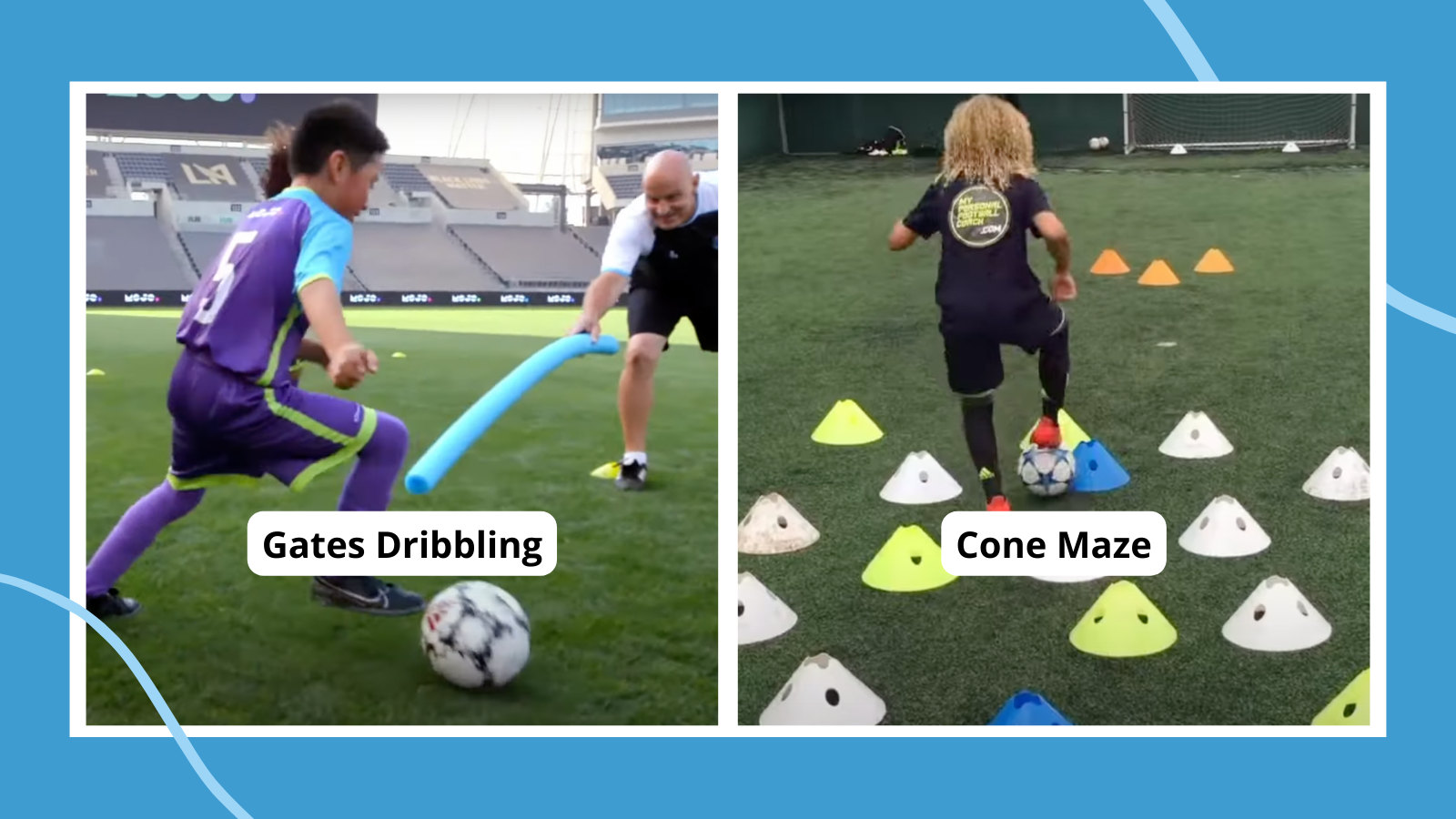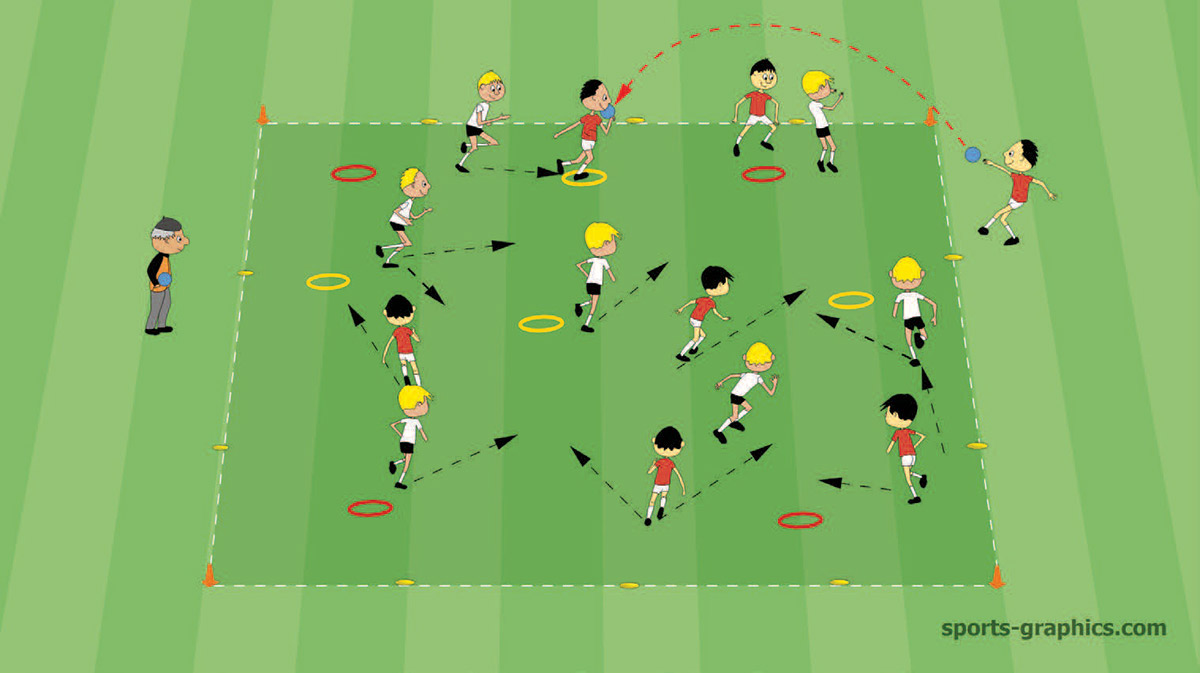Football drills for kids focus on skill development, teamwork, and fun. These drills improve coordination, agility, and basic techniques.
Introducing football drills to kids is essential for building foundational skills. Engaging drills help young players develop coordination, agility, and teamwork. Simple exercises like dribbling through cones, passing in pairs, and shooting at targets keep the sessions enjoyable. Coaches should emphasize positive reinforcement to build confidence.
Short, varied drills maintain interest and prevent boredom. Encouraging kids to practice regularly will enhance their abilities over time. Proper warm-ups and cool-downs are crucial to prevent injuries. Overall, football drills for kids should be structured yet fun, promoting a lifelong love for the game.
Warm-up Exercises
Warm-up exercises are essential for preparing kids for football drills. They help to prevent injuries and improve performance. Warm-ups get the blood flowing and muscles ready for action. Below are some effective warm-up exercises for kids.
Stretching Routines
Stretching helps to increase flexibility and reduce muscle stiffness. Here are some simple stretching routines:
- Arm Circles: Rotate arms forward and backward in small circles.
- Leg Swings: Swing one leg forward and backward, then switch.
- Torso Twists: Stand with feet shoulder-width apart, twist torso left to right.
- Quad Stretch: Stand on one leg, pull the other foot towards the buttocks.
- Calf Stretch: Push against a wall, one leg forward, the other leg back.
Light Jogging
Light jogging helps to increase the heart rate and warm up muscles. It is an important part of the warm-up routine.
- Jog in Place: Kids can jog on the spot for 2 minutes.
- High Knees: Jog while lifting knees as high as possible.
- Butt Kicks: Jog and kick heels towards the buttocks.
- Side Shuffles: Shuffle sideways back and forth for a minute.
- Backwards Jogging: Jog backwards carefully for added balance training.
These exercises are simple yet effective for warming up. They ensure kids are ready for football drills.

Credit: www.weareteachers.com
Basic Ball Handling
Football drills for kids should always start with the basics. Basic ball handling is crucial for young players. It helps them gain control and confidence. Below are some essential drills for dribbling and passing.
Dribbling Techniques
Dribbling is the first skill kids should learn. It helps them navigate the field. Use these techniques to improve their dribbling:
- Inside Foot Dribble: Use the inside part of the foot to move the ball.
- Outside Foot Dribble: Use the outside part of the foot to push the ball.
- Alternating Feet: Switch between the left and right foot while dribbling.
Set up cones in a straight line. Have the kids dribble through the cones. Encourage them to use both feet. This drill improves their control and balance.
Passing Drills
Passing is a vital skill in football. Teach kids to pass accurately with these drills:
- Short Pass: Use the inside of the foot for short passes.
- Long Pass: Use the laces of the foot for longer passes.
- One-Touch Pass: Pass the ball with a single touch.
Pair up the kids. Have them pass the ball back and forth. Encourage them to use both feet. This drill helps improve their accuracy and teamwork.
| Drill | Purpose | Instruction |
|---|---|---|
| Inside Foot Dribble | Control and Navigate | Use the inside part of the foot. |
| Outside Foot Dribble | Speed and Direction | Use the outside part of the foot. |
| Short Pass | Accuracy | Use the inside of the foot. |
| Long Pass | Distance | Use the laces of the foot. |
These basic ball handling drills are perfect for young football players. They are easy to understand and practice. Start with these drills to build a strong foundation.
Shooting Practice
Shooting Practice is a crucial part of football training for kids. It helps them develop accuracy, power, and confidence in their shots. This section focuses on two important aspects of shooting: aiming for accuracy and power shots. Each drill is designed to be fun and engaging, while also improving essential skills.
Aiming For Accuracy
Accuracy is key in football. Kids need to hit their target consistently. Start by setting up a goal with targets in different corners. Use cones or markers to indicate these targets.
Drill 1: Target Practice
- Place a cone in each corner of the goal.
- Kids take turns shooting at each cone.
- Track their progress and encourage improvement.
Drill 2: Hit the Spot
- Draw circles on the goal with chalk.
- Kids aim to hit these circles.
- Reward accurate shots with points.
Power Shots
Power shots are important for scoring from a distance. Kids need to learn how to kick with strength and precision. Use simple drills to boost their power.
Drill 1: Distance Shooting
- Set up markers at different distances from the goal.
- Kids take shots from each marker.
- Focus on maintaining power and accuracy.
Drill 2: Running Start
- Kids start running from a distance.
- They kick the ball while in motion.
- Encourage strong, controlled shots.
Here is a simple table summarizing the drills:
| Drill | Objective | Instructions |
|---|---|---|
| Target Practice | Improve accuracy | Shoot at cones in goal corners |
| Hit the Spot | Enhance precision | Aim for chalk-drawn circles |
| Distance Shooting | Boost power | Shoot from varying distances |
| Running Start | Increase shot strength | Shoot while running |
These drills are fun and effective for young players. Regular practice will help kids develop strong and accurate shots. Get them on the field and start practicing today!

Credit: m.youtube.com
Defensive Skills
Football is not just about scoring goals. Defensive skills are essential for young players. These skills help to protect their team’s goal. They also help in stopping the opposing team from scoring. This section will focus on two main defensive skills: Tackling Drills and Blocking Techniques.
Tackling Drills
Tackling drills teach kids how to take the ball from their opponents. These drills help in building confidence and strength. Here are some fun and effective tackling drills for kids:
- One-on-One Tackling: Pair up the kids. One player tries to run past the other. The defender must stop them by taking the ball.
- Shadow Drills: The defender shadows the attacker. They must stay close and try to take the ball without fouling.
- Tag Team Tackles: Two defenders work together to tackle one attacker. This drill teaches teamwork and communication.
Blocking Techniques
Blocking techniques are crucial for stopping the other team. These techniques help in creating a solid defense line. Here are some effective blocking drills:
| Drill | Description |
|---|---|
| Line Block | Players form a line and block attackers from passing through. |
| Zone Defense | Players cover specific zones. They block any attacker entering their zone. |
| Mirror Drill | Players mirror the movements of the attacker. They must stay in front and block their path. |
These drills make kids better defenders. They learn to protect their goal and stop the other team. Practicing these drills regularly will improve their defensive skills.
Team Coordination
Team coordination is crucial in football. It helps players work together effectively. Kids need to learn how to move as a unit. This section covers drills to improve team coordination. Let’s dive into some effective exercises.
Group Passing Drills
Group passing drills are great for building team coordination. Here are some effective drills:
- Circle Passing: Kids stand in a circle. They pass the ball to each other. This helps them improve accuracy and timing.
- Triangle Passing: Form a triangle with three kids. They pass the ball in a set pattern. This drill enhances communication and quick thinking.
- Relay Passing: Set up two lines of kids. They pass the ball down the line. The last kid runs to the front and starts again.
Communication Exercises
Good communication is key in football. These exercises help kids improve their talking skills on the field:
- Silent Passing: Kids pass the ball without speaking. This drill enhances their ability to read body language and gestures.
- Call and Respond: One kid calls out another’s name before passing. The receiver must reply. This reinforces the habit of calling for the ball.
- Directional Commands: The coach gives directions. Kids follow them while passing. This improves their listening skills and quick response.
Fitness And Conditioning
Fitness and conditioning are essential for young football players. These drills help kids build strength, stamina, and agility. They also make the game more fun and engaging.
Endurance Training
Endurance training helps kids play longer without getting tired. It improves their overall fitness and keeps them active throughout the game.
Here are some effective endurance drills:
- Running Laps: Kids run around the field for 10 minutes.
- Shuttle Runs: Set up cones and have kids run back and forth.
- Jumping Jacks: Do sets of 20 jumping jacks.
These drills should be done regularly to build stamina.
Speed Drills
Speed is crucial in football. Speed drills help kids move quickly and improve their reaction time.
Some effective speed drills include:
- Sprints: Short 20-meter sprints, repeated 5 times.
- High Knees: Run in place, lifting knees high for 30 seconds.
- Butt Kicks: Run in place, kicking heels to the butt for 30 seconds.
These drills should be done at least twice a week.
| Drill | Duration | Frequency |
|---|---|---|
| Running Laps | 10 minutes | 3 times a week |
| Sprints | 20 meters | 5 times a session |
| High Knees | 30 seconds | 2 times a week |
Consistent training leads to improved fitness and conditioning. Kids will enjoy the game more as they get fitter and faster.
Fun Games
Football drills can be fun for kids. Engaging games keep them excited and active. Fun games help children learn teamwork, coordination, and basic football skills. These activities are easy to set up and enjoyable for all ages.
Relay Races
Relay races are a great way to build speed and agility. Kids love the competition and excitement.
- Dribble Relay: Kids dribble the ball through cones.
- Pass and Run: Teams pass the ball and run to the next cone.
- Shuttle Run: Players run back and forth, touching the ground at each end.
Relays teach quick thinking and improve footwork. Kids enjoy the challenge and friendly competition.
Mini-matches
Mini-matches let kids practice real game situations. Smaller teams mean more touches on the ball.
- 3 vs 3: Small teams ensure everyone gets involved.
- Shorter Goals: Use smaller goals to focus on accuracy.
- Quick Matches: Keep games short to maintain energy and focus.
Mini-matches help kids understand game rules and teamwork. These games are fast-paced and keep everyone engaged.
Cool-down Activities
After a fun and energetic football practice, kids need to cool down. Cool-down activities help their bodies relax and recover. These activities also prevent injuries and improve flexibility.
Breathing Exercises
Breathing exercises help kids calm their minds and bodies. Start by having them sit or lie down comfortably. Instruct them to breathe in deeply through their noses. Hold the breath for three seconds, then exhale slowly through their mouths. Repeat this process five to ten times.
Another fun breathing exercise is the “Balloon Breath”. Ask the kids to imagine they are blowing up a big balloon. They should take a deep breath and then slowly blow out as if inflating a balloon. This makes cooling down more engaging.
Gentle Stretching
Gentle stretching is essential after football drills. It helps muscles relax and recover. Start with simple neck stretches. Have the kids gently tilt their heads to each side, holding for five seconds each.
Next, move to shoulder stretches. Kids can place one arm across their chest and use the other arm to gently pull it closer. Hold each stretch for ten seconds.
For leg stretches, try the “Butterfly Stretch”. Kids sit with the soles of their feet together and gently press their knees towards the ground. Hold this position for ten seconds.
| Stretch | Position | Hold Time |
|---|---|---|
| Neck Stretch | Sit or stand | 5 seconds each side |
| Shoulder Stretch | Sit or stand | 10 seconds each arm |
| Butterfly Stretch | Sit | 10 seconds |
These cool-down activities are important for kids. They ensure kids stay healthy and enjoy their football practice.

Credit: soccer-coaches.com
Frequently Asked Questions
What Are Basic Football Drills For Kids?
Basic football drills for kids include dribbling, passing, and shooting. These help develop essential skills and confidence on the field.
How Often Should Kids Practice Football Drills?
Kids should practice football drills 2-3 times a week. Regular practice helps improve their skills and game understanding.
Are Football Drills Safe For Young Kids?
Yes, football drills are safe when done properly. Ensure children use the right equipment and follow safety guidelines.
What Age Can Kids Start Football Drills?
Kids can start football drills as young as 4 years old. Tailor drills to their age and skill level.
Conclusion
Football drills for kids are essential for skill development and fun. They build teamwork and physical fitness. With consistent practice, children improve their techniques and gain confidence. Parents and coaches should encourage regular drills to foster a love for the game.
Start incorporating these drills today for a brighter football future.




